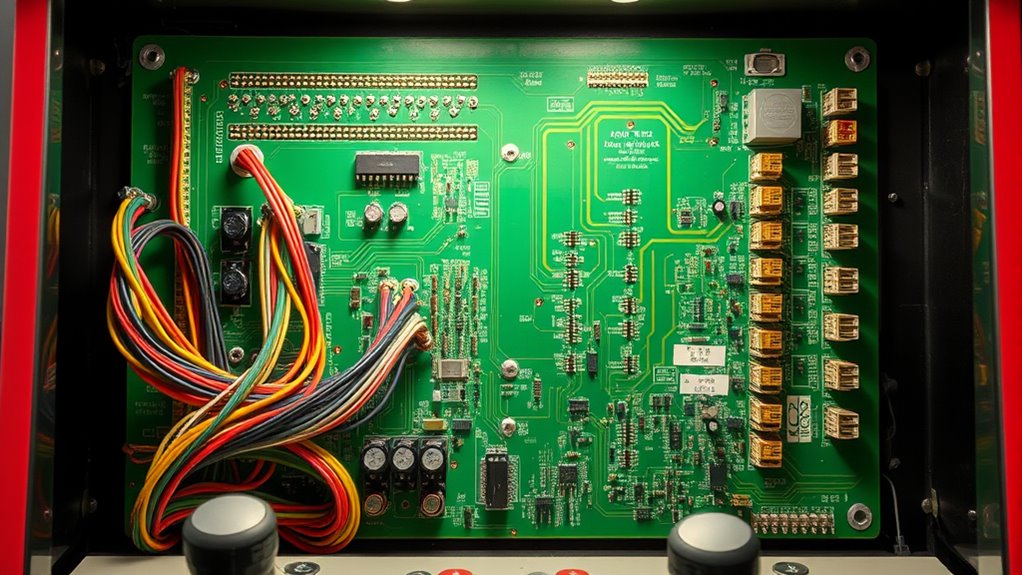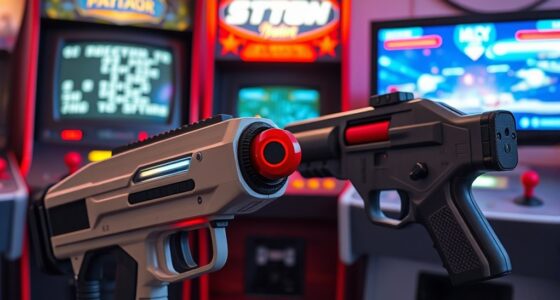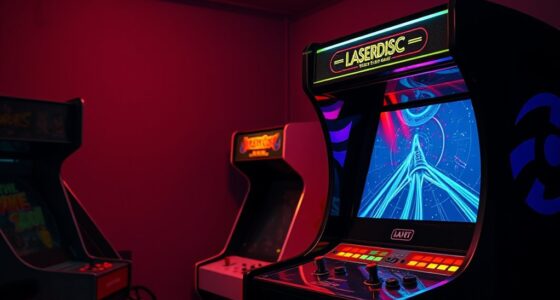Inside the cabinet, the JAMMA standard streams wiring by using a universal connector system, making it easy to swap and upgrade arcade boards, controls, and video signals. It connects power supplies, joysticks, buttons, and monitors through organized, standardized pinouts, ensuring reliable signals and straightforward troubleshooting. This modular design simplifies maintenance and compatibility across different arcade machines. To understand how it works and its benefits, you’ll find that each component aligns with a smart, flexible system ready for upgrades.
Key Takeaways
- The JAMMA standard uses a universal multi-pin connector to link arcade PCBs, power supplies, controls, and monitors.
- It organizes wiring with fixed pinouts, simplifying installation, troubleshooting, and component swapping inside the cabinet.
- Modular harnesses enable quick hardware upgrades and repairs, ensuring compatibility across different arcade systems.
- The standard supports organized cable management to reduce interference and facilitate maintenance within the cabinet.
- JAMMA’s design promotes hardware interoperability, making game swaps and upgrades more efficient and reliable inside the arcade cabinet.
What Is the JAMMA Standard and Why Was It Created?
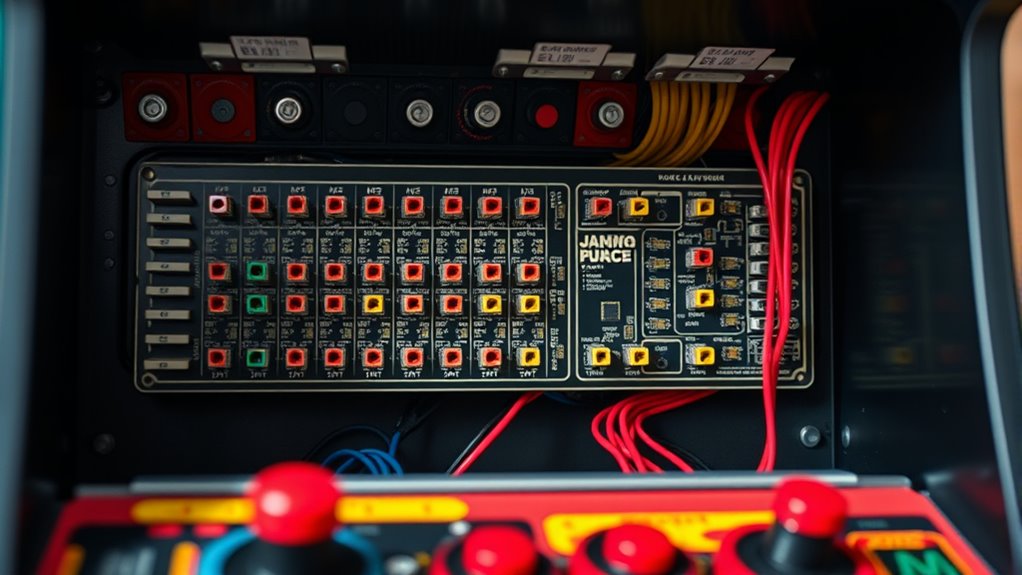
The JAMMA standard is a wiring and connector system designed to simplify arcade game hardware integration. In arcade history, manufacturers faced challenges with incompatible wiring setups, making game swaps difficult and costly. The JAMMA standard was created to address this issue by providing a universal wiring interface, ensuring hardware compatibility across different arcade cabinets. This innovation allowed arcade operators to easily swap games without extensive rewiring, saving time and money. By standardizing connections for power, video, audio, and controls, JAMMA made arcade game maintenance more efficient. Its creation marked a key milestone in arcade history, enabling a more flexible and streamlined arcade environment. Additionally, the JAMMA standard facilitated easier hardware upgrades and repairs, contributing to the longevity of arcade cabinets. Today, the JAMMA standard remains a foundational element in maintaining and restoring classic arcade cabinets.
The Key Components of a JAMMA-Compatible Arcade Cabinet
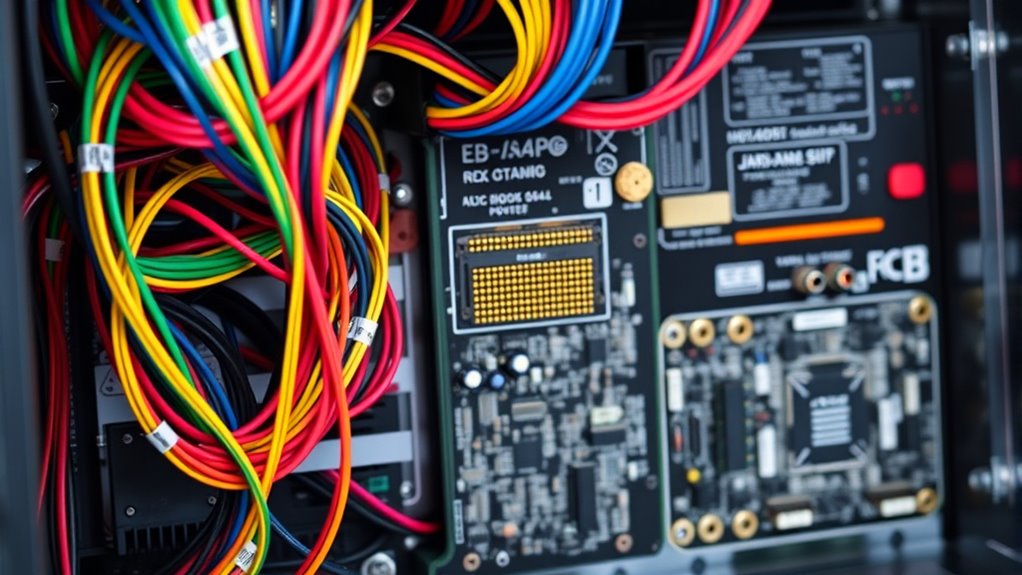
To understand a JAMMA-compatible arcade cabinet, you need to look at the main PCB connections and control interface layout. These components are essential for proper operation and easy upgrades. Let’s explore how they connect and what makes them standardized across different machines. Additionally, the electrical wiring within the cabinet follows specific standards that ensure compatibility and ease of maintenance.
Main PCB Connections
Connecting the main PCB to a JAMMA arcade cabinet involves plugging in a standardized multi-pin connector that transmits power, audio, video, and control signals. This connector links the PCB to essential components like the coin door and power supply, enabling coin insertion to trigger game start and managing power distribution. The power supply supplies the necessary voltage and current to run the PCB and other cabinet parts. Make sure the connector is securely attached to prevent signal loss or malfunctions. The JAMMA connector’s design ensures compatibility across different arcade cabinets, simplifying maintenance and upgrades. Proper connection ensures smooth operation, clear audio and video output, and reliable control input from joysticks and buttons. Ensuring standardized connections are properly configured is vital for optimal performance. This setup forms the backbone of your arcade’s electronic system, ensuring everything functions seamlessly.
Control Interface Layout
Ever wonder what makes a JAMMA-compatible arcade cabinet responsive and easy to operate? It’s the control interface layout, which connects your controls to the main PCB seamlessly. The control panel is designed with standard connectors and wiring, ensuring compatibility and quick maintenance. It typically features joysticks, buttons, and sometimes trackballs, all arranged for ideal arcade aesthetics. Here’s a quick breakdown:
| Component | Function | Placement |
|---|---|---|
| Joystick | Moves characters or cursors | Top left/right |
| Action Buttons | Perform game actions | Near joystick |
| Wiring Harness | Connects controls to PCB | Under control panel |
This layout guarantees consistent gameplay, easy setup, and a clean look. Your control panel is the heart of user interaction, making gameplay intuitive. Proper control interface layout ensures smooth operation and enhances the overall gaming experience.
How JAMMA Connects the Hardware in Arcade Machines
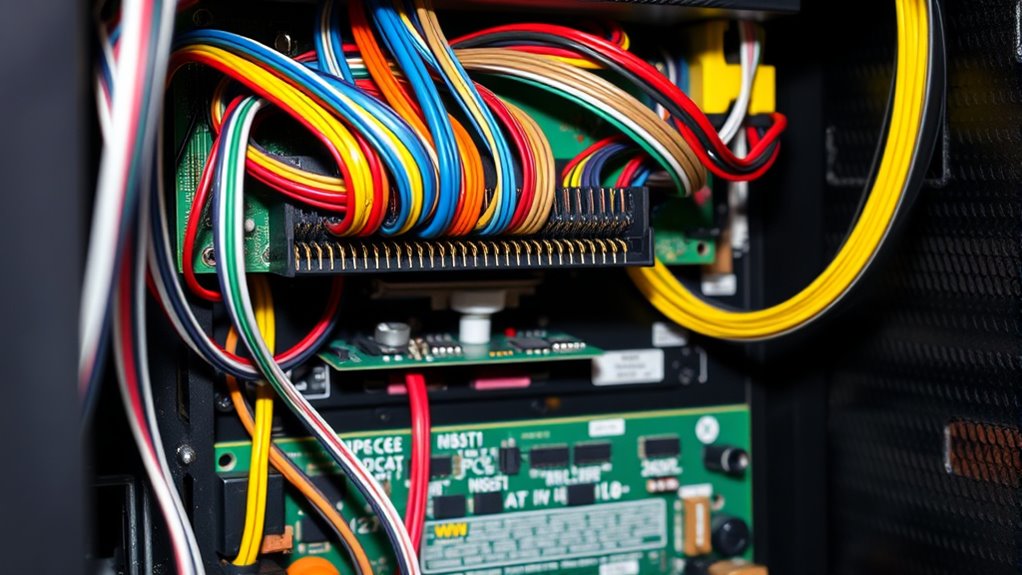
You’ll see that JAMMA uses a standardized pinout design to guarantee compatibility across different hardware. Its modular connections make it easy to swap components without rewiring everything. Signal transmission methods are optimized to ensure reliable communication between the arcade’s parts. Additionally, the holistic design of JAMMA systems promotes durability and ease of maintenance for arcade operators.
Standardized Pinout Design
The JAMMA standard employs a fixed pinout design, ensuring that arcade hardware components can be easily connected and swapped without compatibility issues. This consistency is reflected in pinout diagrams, which clearly map each connection point, making troubleshooting and replacements straightforward. The connector standards used by JAMMA are uniform, allowing different hardware manufacturers to create compatible components. Because of this standardized pinout, you can swap PCBs, controls, and power supplies with minimal effort, saving time and reducing errors. This design also simplifies maintenance, as technicians can quickly identify and access specific connections. Another advantage is the ease of customization, allowing arcade operators to tailor their setups to specific needs or preferences. Overall, the standardized pinout ensures that arcade machines remain versatile, adaptable, and easier to service, maintaining JAMMA’s reputation as a reliable and efficient interface for arcade hardware.
Modular Hardware Connections
Modular hardware connections in JAMMA arcade systems enable quick and straightforward assembly, replacement, and upgrades. This is achieved through standardized wiring harnesses that connect the game board to other cabinet components. These harnesses simplify wiring by matching circuit diagrams, ensuring consistent connections. When you need to swap or repair hardware, you just disconnect and reconnect the harnesses without hassle. The JAMMA connector acts as the main interface, linking the arcade PCB to the cabinet’s power supply, controls, and monitor. This modular approach minimizes downtime and streamlines maintenance. Here’s a quick overview: 1. Wiring harnesses standardize connections across cabinets. 2. Circuit diagrams guide correct wiring during setup. 3. The JAMMA connector links all hardware components seamlessly. Additionally, understanding best arcade movies can enhance your appreciation of arcade game design and culture.
Signal Transmission Methods
Signal transmission in JAMMA arcade systems relies on a standardized method of sending electrical signals between the game board and other hardware components. You’ll notice that ribbon cables are common for connecting inputs, outputs, and power lines, ensuring a compact and organized setup. These cables help maintain signal integrity by reducing interference and signal loss over distance. To clarify, here’s a quick overview:
| Component | Connection Method |
|---|---|
| Power Supply | Dedicated power lines |
| Input Devices | Ribbon cables from controls |
| Video Output | Multi-pin connector |
| Sound System | Signal wires via connector |
This method guarantees consistent communication, making sure your arcade machine runs smoothly and reliably. Additionally, JAMMA standard ensures compatibility across various hardware components, simplifying upgrades and maintenance.
Benefits of Using the JAMMA Standard in Arcade Design
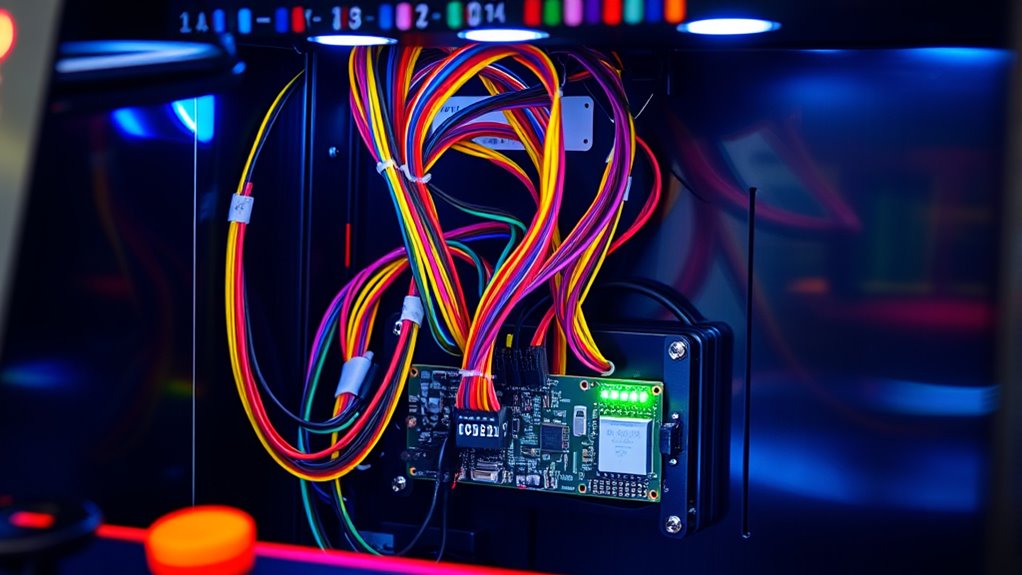
Adopting the JAMMA standard offers significant advantages for arcade design by simplifying hardware interoperability. It streamlines the process of connecting and swapping game boards, saving you time and money. This compatibility fosters a sense of arcade nostalgia by preserving classic hardware setups while allowing easy updates. With JAMMA, you can quickly maintain or upgrade machines without extensive rewiring, making your arcade more efficient. Additionally, the standardized connections facilitate easy customization to fit different arcade themes or preferences.
Differences Between JAMMA and Other Arcade Wiring Systems
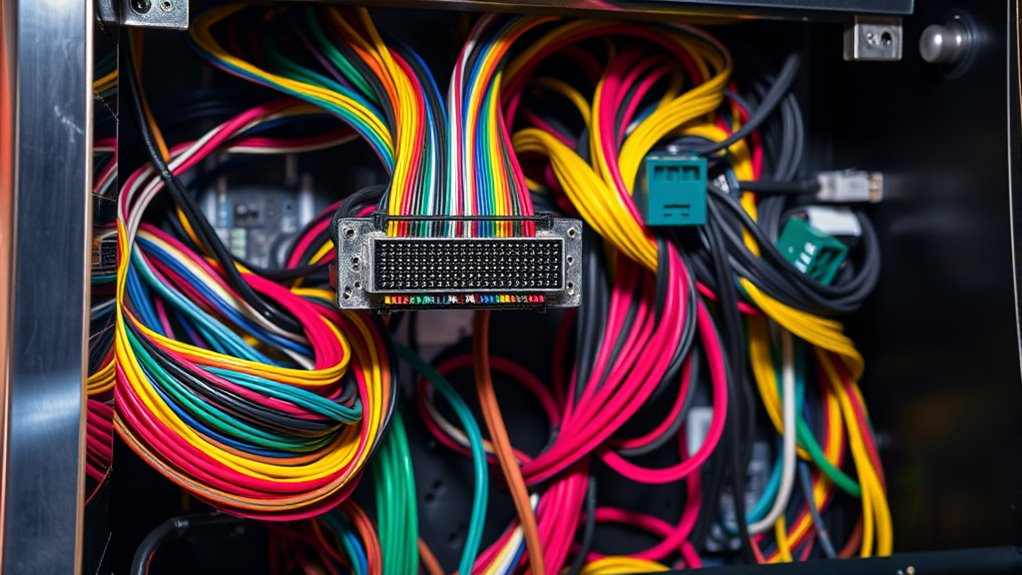
While JAMMA sets a standard for simplified arcade hardware connections, it’s important to recognize how it differs from other wiring systems used in arcade machines. Unlike vintage hardware setups that often feature custom wiring, JAMMA offers a universal wiring compatibility, making it easier to swap out games without rewiring the cabinet. Older systems might require direct connections for each component, increasing complexity and maintenance time. JAMMA’s standardized edge connector consolidates controls, power, and video signals into a single interface, reducing the need for custom wiring. This compatibility simplifies upgrades and repairs, especially for arcade owners who want to preserve or restore vintage hardware. Overall, JAMMA’s design streamlines wiring and enhances interoperability, unlike more fragmented, less standardized wiring systems used in traditional arcade machines.
Setting Up and Troubleshooting JAMMA Connections
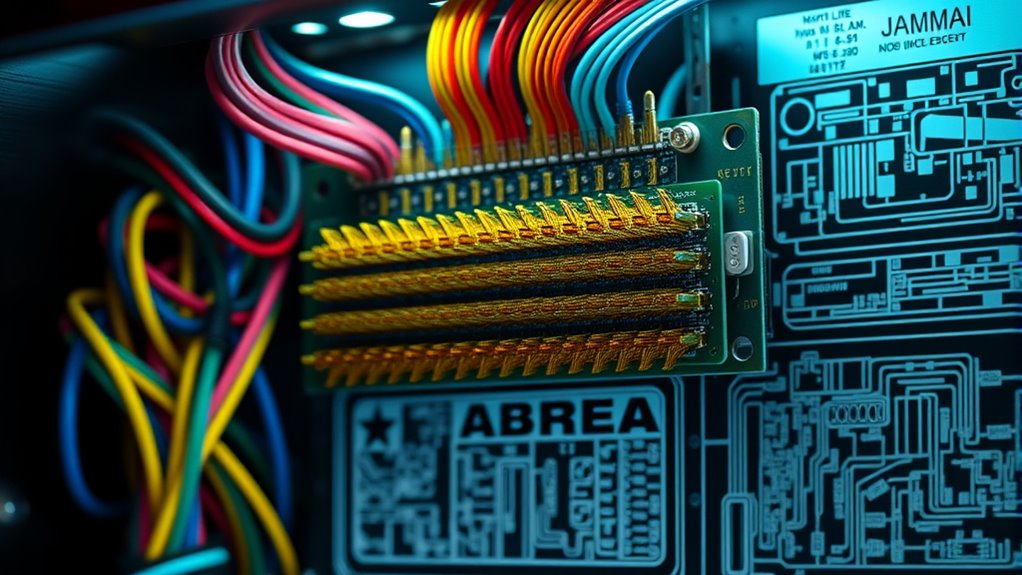
Setting up and troubleshooting JAMMA connections requires careful attention to detail, but once you understand the process, it becomes straightforward. Proper cable management helps prevent loose connections and makes troubleshooting easier. To get started:
- Check all connectors for secure, proper seating, and inspect cables for damage.
- Organize cables neatly to avoid tangling or interference, which can cause signal issues.
- Use troubleshooting techniques like testing continuity with a multimeter or swapping components to identify faults quickly.
The Future of the JAMMA Standard in Modern Arcade Gaming
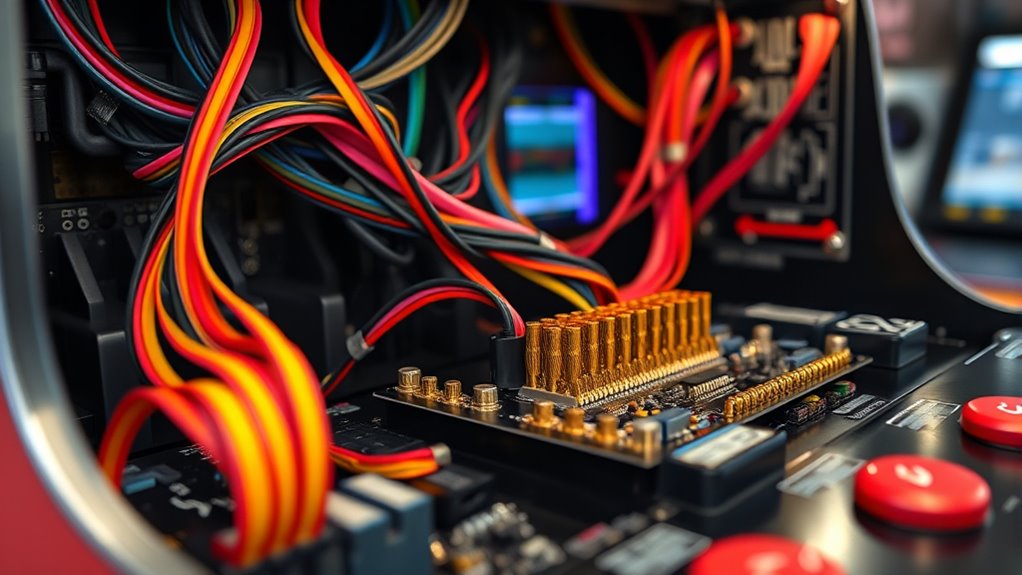
As arcade gaming evolves, the role of the JAMMA standard is shifting to meet new technological demands. While it once defined how arcade cabinets connected, today, it faces challenges from modern adaptations and the growing desire for arcade nostalgia. Developers are updating JAMMA-compatible hardware to support high-definition displays and advanced controls, ensuring retro games remain relevant. You might see new interfaces that blend classic setups with modern tech, allowing for easier customization and enhanced performance. The future of JAMMA isn’t about replacing the standard but evolving it to keep pace with contemporary gaming trends. This way, you can enjoy the charm of arcade nostalgia while benefiting from innovative updates that make arcade cabinets more versatile and future-proof.
Frequently Asked Questions
Can JAMMA Be Integrated With Modern Digital Arcade Systems?
You can definitely integrate JAMMA with modern digital arcade systems. The key is understanding how to leverage hardware adaptability, which allows older JAMMA boards to connect with newer digital components. By using appropriate adapters and interface cards, you enable seamless digital integration, making your arcade setup versatile and future-proof. This approach guarantees you preserve your classic hardware while taking advantage of modern digital features and upgrades.
Are There Compatibility Issues Between Different Manufacturers’ JAMMA Boards?
When considering compatibility issues between different manufacturers’ JAMMA boards, you find that manufacturer compatibility can sometimes be a concern due to slight variations in design. Board interoperability generally works well if the JAMMA standard is followed correctly, but you might encounter issues if certain boards have non-standard features or custom modifications. Always verify that the boards adhere strictly to the JAMMA standard to guarantee smooth integration and avoid compatibility problems.
How Do I Upgrade an Older Arcade Cabinet to JAMMA Standard?
Upgrading your older arcade cabinet to the JAMMA standard feels like merging vintage charm with modern ease. You’ll need to modify the arcade wiring and make a few cabinet modifications, like installing a JAMMA harness and ensuring proper power connections. This process simplifies board swaps and enhances compatibility with newer games. Think of it as bridging the past and present, transforming your cabinet into a versatile gaming centerpiece.
What Safety Precautions Should Be Taken When Working With JAMMA Wiring?
When working with JAMMA wiring, you should prioritize electrical safety by unplugging the cabinet before starting and wearing insulated gloves. Follow wiring best practices, like using proper connectors and avoiding loose or frayed wires. Double-check connections to prevent shorts, and keep your workspace dry. Always test your wiring carefully before powering up the cabinet to guarantee safety and proper operation.
Is JAMMA Suitable for Home Arcade Setups or Only Commercial Use?
JAMMA is great for your home arcade because it simplifies DIY installation and makes swapping games easy. While it’s primarily used in commercial setups, its standardized design means you can easily set up a home arcade with JAMMA. Just make certain you have the right wiring and safety precautions in place, and you’ll enjoy a flexible, professional-quality gaming experience right at home without needing custom wiring for each cabinet.
Conclusion
Understanding the JAMMA standard open the full potential of your arcade setup, making repairs and upgrades smoother than ever. By mastering its components and connections, you’re not just maintaining machines—you’re harnessing the backbone of arcade history itself. Embrace JAMMA, and you’ll be wielding a legendary tool that’s stood the test of time, outlasting trends and tech innovations. It’s more than a standard—it’s the heartbeat of arcade gaming greatness!
